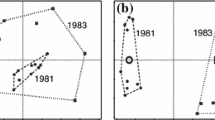Abstract
Multivariate analyses of vegetation data have been restricted to a single scale of sampling, or multiscale sampling has been restricted to a single species. However, vegetation scientists need to be able to explore spatial relationships of many species over many scales. We present a modification of Noy-Meir & Anderson's (1971) method of multiscale ordination by summing two-term local covariance matrices and smoothing the component profiles. The advantages of our method are: 1) results are less subject to the starting position of the transect, 2) matrices may be added at any block size, and 3) plots of factor scores are smoothed by a moving weighted average to better reveal patterns at a prescribed scale.
This procedure provides statistical associations of species over a range of scales. The scales which exhibit the association to the maximum extent are then determined from multiscale ordination. The relationships of different associations and their scales can then be examined. The application of the method to fabricated data proved successful in recovering the structure built into the data. When used on real vegetation data, from a community and a landscape, the method revealed the details of species associations over a range of scales, and of the relationships among associations.
Similar content being viewed by others
Abbreviations
- PCA =:
-
Principal Components Analysis
- DCA =:
-
Detrended Correspondence Analysis
- TTLC =:
-
Two-Term Local Covariance
References
Allen, T.F.H. & Starr, T.B. 1982. Hierarchy. Perspectives for ecological complexity. Univ. Chicago Press, Chicago.
Bouxin, G. 1983. Multi-scaled pattern analysis: An example with savanna vegetation and a proposal for sampling design. Vegetatio 52: 161–169.
Bouxin, G. & Gautier, N. 1982. Pattern analysis in Belgium limestone grasslands. Vegetatio 49: 65–83.
Castro, I., Sterling, A. & Galiano, E.F. 1986. Multi-species pattern analysis of Mediterranean pastures in three stages of ecological succession. Vegetatio 68: 37–42.
Forman, R.T.T. & Godron, M. 1986. Landscape ecology. John Wiley and Sons, New York.
Galiano, E.F. 1983. Detection of multispecies patterns in plant populations. Vegetatio 53: 129–138.
Gibson, D.J. & Greig-Smith, P. 1986. Community pattern analysis: A method for quantifying community mosaic structure. Vegetatio 66: 41–47.
Glenn-Lewin, D.C. & VerHoef, J.M. 1988. Prairies and grasslands of the St. Croix National Scenic Riverway, Wisconsin and Minnesota. Prairie Naturalist 20: 65–80.
Greig-Smith, P. 1952. The use of random and contiguous quadrats in the study of the structure of plant communities. Ann. Bot. 16: 293–316.
Greig-Smith, P. 1983. Quantitative plant ecology. 3rd ed. Blackwell Sci. Publ., Oxford.
Hill, M.O. 1973. The intensity of spatial pattern in plant communities. J. Ecology. 61: 225–235.
Hill, M.O. & Gauch, H.G. 1980. Detrended correspondence analysis: An improved ordination technique. Vegetatio 42: 47–58.
Kenkel, N.C. & Orlóci, L. 1986. Applying nonmetric multidimensional scaling to ecological studies: Some new results. Ecology 67: 919–928.
Kershaw, K.A. 1957. The use of cover and frequency in the detection of pattern in plant communities. Ecology 38: 291–299.
Kershaw, K.A. & Looney, J.H.H. 1985. Quantitative and dynamic plant ecology. Edward Arnold, London.
Noy-Meir, I. & Anderson, D.J. 1971. Multiple pattern analysis, or multiscale ordination: Towards a vegetation hologram? In: Patil, G.P., Pielou, E.C. & Waters, W.E., (eds), Many species populations, ecosystems and systems analysis. Stat. Ecol. Ser. 3: 207–231. Pennsylvania State Univ. Press, University Park.
Prentice, I.C. 1977. Non-metric ordination methods in ecology. J. Ecology 65: 85–94.
Usher, M.B. 1969. The relation between mean square and block size in the analysis of similar patterns. J. Ecology 57: 505–514.
White, P.S. & Pickett, S.T.A. 1985. Natural disturbance and patch dynamics: An introduction. In: Pickett, S.T.A. & White, P.S. (eds), The ecology of natural disturbance and patch dynamics: 3–13. Academic Press, Orlando, Fl.
Whittaker, R.H. & Naveh, Z. 1979. Analysis of a two-phase pattern. In: Patil, G.P. & Rosenzweig, M.L., (eds), Contemporary quantitative ecology and related econometrics. Stat. Ecol. Ser. 12: 157–165. Internat. Coop. Publ. House, Burtonsville, Md.
Author information
Authors and Affiliations
Rights and permissions
About this article
Cite this article
Ver Hoef, J.M., Glenn-Lewin, D.C. Multiscale ordination: a method for detecting pattern at several seales. Vegetatio 82, 59–67 (1989). https://doi.org/10.1007/BF00217983
Accepted:
Issue Date:
DOI: https://doi.org/10.1007/BF00217983




